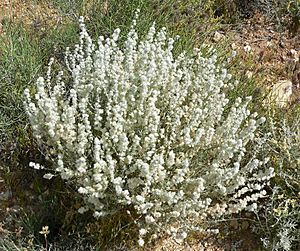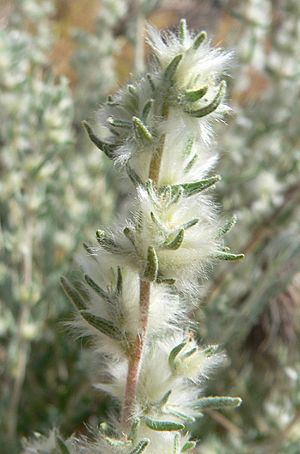Winterfat facts for kids
Quick facts for kids Winterfat |
|
|---|---|
 |
|
| Scientific classification | |
| Genus: |
Krascheninnikovia
|
| Species: |
lanata
|
| Synonyms | |
|
Ceratoides lanata (Pursh) J.T. Howell |
|
Winterfat, also known as Krascheninnikovia lanata, is a type of flowering plant. It belongs to the Amaranthaceae family. This plant grows naturally across a large part of western North America. You can find it from central Western Canada down through the Western United States and into northern Mexico.
The plant's scientific name, Krascheninnikovia, honors Stepan Krasheninnikov. He was a Russian botanist and explorer in the early 1700s. He explored places like Siberia and the Kamchatka region.
Contents
Where Winterfat Grows
Winterfat can grow in many different places, called habitats. It lives at elevations from about 330 feet (100 meters) up to 8,860 feet (2,700 meters). You can find it in flat grasslands, dry scrublands, and even on the drier sides of mountains (called rain shadow areas).
This plant is special because it's a halophyte. This means it can grow well in salty soils. You'll often see winterfat in places with salty ground, like alkali flats. These areas include the Great Basin, Central Valley, Great Plains, and Mojave Desert.
What Winterfat Looks Like
Winterfat is a small shrub. It has upright stems that can grow between 1.5 feet (0.5 meters) and 3 feet (1 meter) tall. Its leaves are flat and shaped like a spear, growing up to about 1 inch (3 centimeters) long.
Both the stems and the gray leaves are covered in soft, white, woolly hairs. As the plant gets older, these hairs can turn a reddish color.
Winterfat Flowers and Seeds
From March to June, the tops of the stems have many flower spikes. Most winterfat plants have both male and female flowers on the same plant. The male flowers are usually at the top of the spike. They have large, woolly, leaf-like parts called bracts.
The female flowers are smaller and are found closer to the bottom of the spike. After flowering, these female flowers develop into tiny white fruits. These fruits have silky hairs that help them float on the wind, spreading the seeds to new places. This is how the plant's seeds travel and grow.
Growing Winterfat Plants
Winterfat is grown by special plant nurseries. People use it as an ornamental plant in their yards. It's great for xeriscape gardens, which need very little water. It's also good for wildlife gardens and natural landscapes that use native plants.
The light gray leaves of winterfat can make a garden look unique and interesting. These plants are also known to live for a very long time.
How Winterfat Is Used
Winterfat is a very important plant for animals, especially in winter. It stays green all year, which is why it's called "winterfat." This makes it a good food source for grazing animals, both wild ones and farm animals.
Traditional Native American Uses
Many Native American tribes used winterfat as a traditional medicinal plant. These tribes lived in the areas where winterfat grows naturally in North America. They used plants to help with many different health problems and for other benefits. For example, the Zuni people would grind up the root of the winterfat plant. They would then make a soft, moist cloth (called a poultice) to put on burns.
See also
 In Spanish: Krascheninnikovia lanata para niños
In Spanish: Krascheninnikovia lanata para niños


